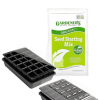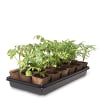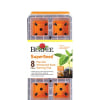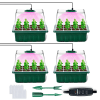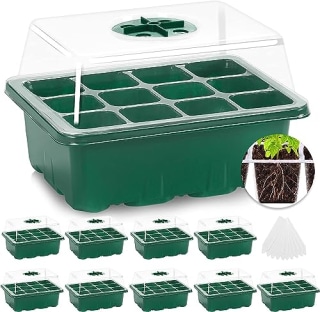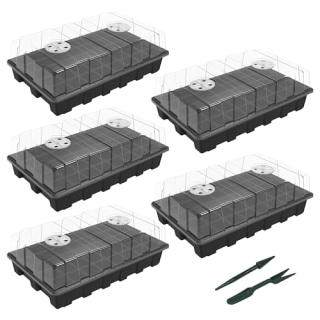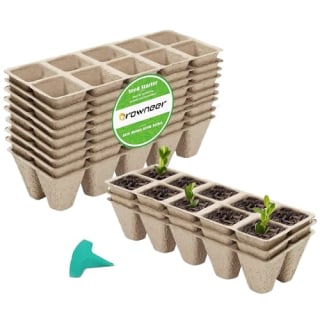Whether you’re interested in gardening as a hobby, a side hustle or simply want beautiful blooms in your space, you’ll need some basic essentials. Besides durable gloves, a raised bed and other gardening supplies, a seed starting tray can help to jumpstart your journey too.
SKIP AHEAD How I picked the best seed starting trays | The best seed starting trays | How to shop for seed starting trays | Why trust NBC Select?
To help you choose the best ones, I consulted gardening experts for shopping advice and compiled a list of their recommendations — bestselling brands like Gardener’s Supply and Burpee are included.
How I picked the best seed starting trays
Both DeVito and Heinrich stress the following factors, which I kept in mind when pulling together this list:
Material: Seed starting trays are available in either plastic or some sort of composted material, such as peat, wood pulp and coir (coconut fibers). Seed trays made from peat, for example, are beneficial because you can plant them directly into native soil once the seeds have germinated and sprouted. That said, trays made from composted material are sometimes not as durable as plastic options. Plastic seed trays are prized because they hold up well against root growth and different elements that may disturb the plant. If you do use plastic trays to grow edible plants, look for ones that are BPA free. Both types are included below.
Watering: Seedlings also need sufficient water to grow. In addition to watering cans, you can often buy watering trays, sometimes called a reservoir, bottom tray or propagation tray, which goes under the cells of the seed starting tray. Depending on what you’re planting, you can water seedlings in seed trays by either watering them from above or by adding water to the tray below. Since seed starting trays have small holes on the bottom, it allows the plants to absorb water from below. Ensuring you have the space, supplies and time to do this regularly is important if you plan on using a seed starting tray. Several of our options include propagation trays.
Light exposure: Plants sown in seed starting trays should be placed wherever they can get sufficient light exposure. If using artificial light, however, make sure those plants are easy to grow under such conditions, according to DeVito. “I recommend using [seed starting trays] to start plants like tomatoes, peppers, eggplants, zucchini and some flowering perennials that do best when they are started indoors under lights,” she says. “This gives them a head start for the season to flower or produce fruit and other edible parts quicker.” You can also buy seed starting trays with grow light attachments if your access to natural light is limited. Our list includes one option with a grow light.
Soil type: Soil is foundational to plant growth, and different types may be better suited for certain types of plants. You can buy a seed starting mix that’s premade or you can make your own using a mix of soil and fertilizer.
The best seed starting trays in 2025
Below, I rounded up seed starting trays recommended by our experts and ones that have at least a 4-star average rating from at least 500 reviews on Amazon. All of them are either made of plastic, silicone or biodegradable material.
Gardener’s Supply Company Seed Starting Tray (Two 24-cell trays)
- Self-watering system
- Comes with dome cover
- Plastic could be sturdier
This plastic seed starting tray from Gardener’s Supply Company comes recommended by DeVito, who says it’s a great option for beginners. The seed-starting kit has two 24-cell seed starting trays with a propagation tray for watering, two germination dome covers which regulate temperature, a six-quart bag of seed starting soil mix, a capillary mat and wooden seedling marking sticks. While the seed starting tray is suitable for both indoor and outdoor gardening, it’s best if used for growing indoor or greenhouse seedlings, according to the brand. The propagation tray underneath the seed tray helps maintain water over time, so your plants receive continuous self-watering, according to the brand.
Gardener’s Supply Company Square Biodegradable Pots & Tray Set (18 pots)
- Biodegradable material
- Can plant directly in soil
- Be wary with inclement weather
This biodegradable seed starting tray, also from Gardener’s Supply Company, comes recommended by DeVito, who says it’s good for gardeners who want an eco-friendly option. As is common with biodegradable seed starting trays, you can plant these pots directly into the ground due to the organic material. The wood fiber cells are both durable enough to help promote plant growth for seedlings but they’re also easy to work with when transplanting them into your garden bed.
Burpee SuperSeed Seed Starting Tray (8 XL cells)
- Flexible silicone material
- Good for small spaces
- Modern looking
- Not biodegradable
This vibrant, modern-looking silicone seed starting tray from Burpee is a perfect option for gardeners with limited space, like a windowsill, according to DeVito. The tray has the same features of a typical plastic or biodegradable tray, such as small holes underneath for soaking up and draining water. The most unique aspect, however, is the pliable silicone bottoms that allow you to easily press the seedlings out of the cells and transplant into native soil or a large pot when ready.
Mixc Seed Starter Tray with Humidity Dome (12-cell 10-pack)
- Adjustable vents
- Compatible with heating mats
- Transparent cells
- Not biodegradable
This Mixc seed starting tray has everything growers want to sow multiple types of seeds. The plastic tray kit includes a cell tray and a propagation tray, both of which fit together underneath a plastic humidity dome, also included. The dome cover also has adjustable vents on the top that you can change by hand, depending on the weather or climate you want to expose your plants to. The tray is also safe to use with a heat mat, according to the brand. That means you can have even more control over the temperature around your plants, which is important if you live in a particularly cold environment. The model has a 4.5-star average rating from over 9,000 reviews on Amazon.
Gardzen Seed Starting Trays with Dome and Base (40-cell 5-pack)
- Double vents
- Humidity dome
- Sturdy plastic
- Not biodegradable
- Best for growing in bulk
The Gardzen seed starting tray has all of the basics required for setting up your seedlings. The model has the usual multi-cell seed tray, draining holes on the bottoms and a plastic humidity dome for temperature regulation. Since the brand offers large capacity cell trays, with both 40-cell and 70-cell options, each of the tray kits have domes with multiple adjustable vents on the top for optimal temperature regulation. It also has a 4.5-star average rating from over 7,000 reviews on Amazon.
Growneer Peat Pots Seed Starter Trays (10-cell 12-pack)
- Biodegradable
- Dividable
- Not as durable as plastic
The Growneer seed trays are made from peat, a biodegradable material made of composted organic material, which makes them ideal for planting the seedlings directly into the ground once they sprout. The brand sells 10-cell and six-cell trays, both of which come with T-shaped plant labels that you can stick into each cell with soil. A benefit of peat seed starting trays like this one, is that you can cut and separate each cell however you want.
Yaungel Seed Starter Tray with Grow Light (12-cell 4-pack)
- Has a grow light
- Remote controlled
- Only has 12 cells
If you plan on using your seed starting tray indoors, consider purchasing one with a grow light. While many plants and seedlings thrive while growing indoors, a grow light can help make the germination process smoother and faster. A grow light also makes it easier to provide your plants with light, regardless of where in your home they are, especially a space with limited natural light. The light on this tray has adjustable settings that can be controlled with a remote. Plus, it has a 4.3-star average rating from over 2,000 reviews on Amazon.
How to shop for seed starting trays
If it’s your first time shopping for seed starting trays, it’s important to keep certain features in mind, such as the material of the tray, the size and number of cells, and where you plan on transplanting the seedlings. It’s also crucial to make sure you have the proper space to transfer them to, such as a large flower pot or garden bed.
Types of seed starting trays
The type of seed starting tray you choose also matters. Seed starting trays are either made from plastic or composted material such as peat or wood fibers. Both work fine for growing seedlings, but there are benefits and drawbacks to using each type, which we explain below.
Plastic seed starting trays
Plastic trays are a popular choice for growing seedlings because they’re durable enough to use multiple times. “The plastic [seed starting trays] are theoretically reusable and usually cheaper,” says DeVito. “[And] depending on the type of plastic, possibly recyclable.” That said, plastic seed starting trays are less environmentally friendly compared to peat trays since you have to remove the seedlings by hand to transplant them into garden beds or native soil.
Biodegradable seed starting trays
Biodegradable trays are also commonly used for starting seeds because they don’t require disturbing the plant roots while transplanting. Since they’re made from organic material, they’re safe to plant directly in the ground. That said, if you’re an experienced gardener and plant seedlings often, keep in mind that using peat trays requires buying new ones annually, which can be costly for some.
Meet our experts
At NBC Select, we work with experts who have specialized knowledge and authority based on relevant training and/or experience. We also take steps to ensure all expert advice and recommendations are made independently and without undisclosed financial conflicts of interest.
- Carmen DeVito is a professional garden designer, certified New York state landscape professional and the founder of garden consulting company Garden Cult.
- Nathan Heinrich is a gardening designer and horticulturalist.
Why trust NBC Select?
I am a commerce editor at NBC Select, where I've also written about the best pruning shears and fertilizers. To find the best seed starting trays, I spoke with a professional gardener and horticulturalist for their insight, recommendations and guidance.
Catch up on NBC Select’s in-depth coverage of tech and tools, wellness and more, and follow us on Facebook, Instagram, Twitter and TikTok to stay up to date.

